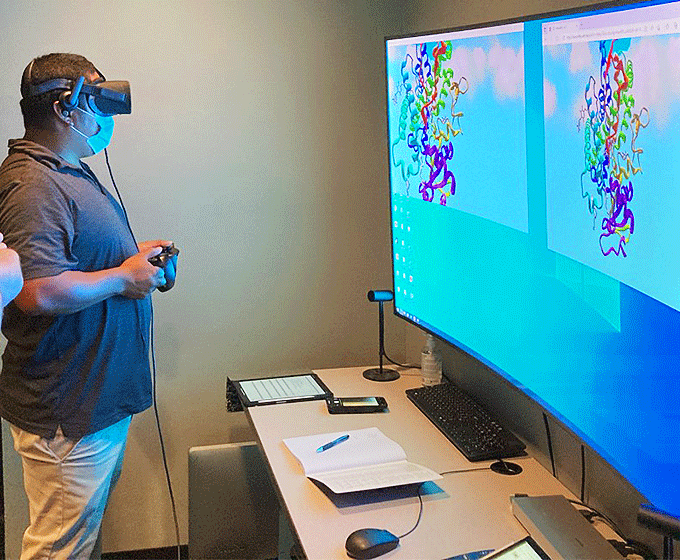Francis Yoshimoto, an assistant professor in the Department of Chemistry at the University of Texas at San Antonio, is teaching his Biochemistry II laboratory students how to use virtual reality headsets to see and study protein structures.
 Francis Yoshimoto’s Biochemistry II laboratory students were able to explore proteins in a unique way by utilizing virtual reality headsets in UTSA’s VizLab. Image Credit: University of Texas at San Antonio.
Francis Yoshimoto’s Biochemistry II laboratory students were able to explore proteins in a unique way by utilizing virtual reality headsets in UTSA’s VizLab. Image Credit: University of Texas at San Antonio.
Yoshimoto’s students set up the virtual reality (VR) headsets using the Department of Computer Science’s VizLab.
Students used typical computer applications to create snapshots of a protein, such as Chimera or Pymol, and then proceeded to the same section of the protein in ProteinVR, a web-based molecular visualization program that allows users to see proteins using a VR headset.
After comparing the two photos, the students used the protein databank to find other human health-related proteins, such as the SARS CoV-2 spike protein, which the coronavirus utilizes to infect human cells.
Students learned about protein structures using 3D VR headsets, which immersed them in a unique learning experience. Students could alter their viewing angles of the protein and traverse forward and backward using the joystick on the Oculus hand controller while using the ProteinVR viewer with the Oculus headset.
Students could travel inside the protein by wearing the headset. They could simply bend their heads while wearing the headset and continue to go forward and backward with the joystick if they wished to move in a different direction around the protein.
For over 15 years, I have been looking at proteins just on my computer screen. Putting a virtual reality headset on to go inside an actual protein was truly an eye-opening experience for both myself and my students.
Francis Yoshimoto, Assistant Professor, Department of Chemistry, University of Texas at San Antonio
Virtual reality is already being used in the biomedical field. It is being used to help pharmaceutical companies design unique medicines, which is a recent advancement in the development of new treatments.
Yoshimoto’s students were able to apply the knowledge they gained from the classroom in a way that applied to a future profession in biomedical research after being introduced to and trained in VR technology.
The project exemplifies UTSA’s dedication to programs that give students a better knowledge of the marketable skills they will need in the workplace and are especially crucial for historically underrepresented populations in connecting classroom success to life after graduation.